2018 NISSAN MICRA child restraint
[x] Cancel search: child restraintPage 40 of 330
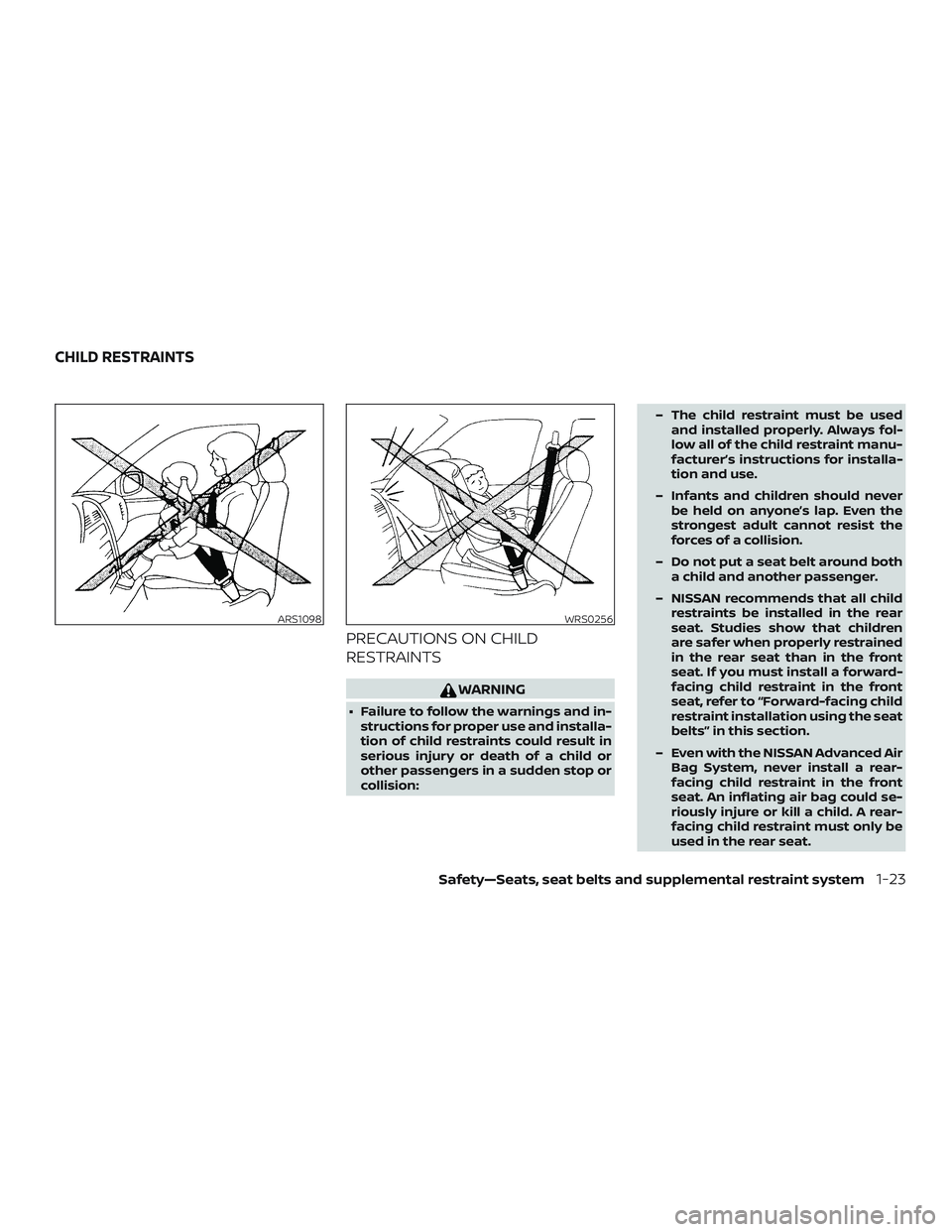
PRECAUTIONS ON CHILD
RESTRAINTS
WARNING
∙ Failure to follow the warnings and in-structions for proper use and installa-
tion of child restraints could result in
serious injury or death of a child or
other passengers in a sudden stop or
collision: – The child restraint must be used
and installed properly. Always fol-
low all of the child restraint manu-
facturer’s instructions for installa-
tion and use.
– Infants and children should never be held on anyone’s lap. Even the
strongest adult cannot resist the
forces of a collision.
– Do not put a seat belt around both a child and another passenger.
– NISSAN recommends that all child restraints be installed in the rear
seat. Studies show that children
are safer when properly restrained
in the rear seat than in the front
seat. If you must install a forward-
facing child restraint in the front
seat, refer to “Forward-facing child
restraint installation using the seat
belts” in this section.
– Even with the NISSAN Advanced Air Bag System, never install a rear-
facing child restraint in the front
seat. An inflating air bag could se-
riously injure or kill a child. A rear-
facing child restraint must only be
used in the rear seat.
ARS1098WRS0256
CHILD RESTRAINTS
Safety—Seats, seat belts and supplemental restraint system1-23
Page 41 of 330
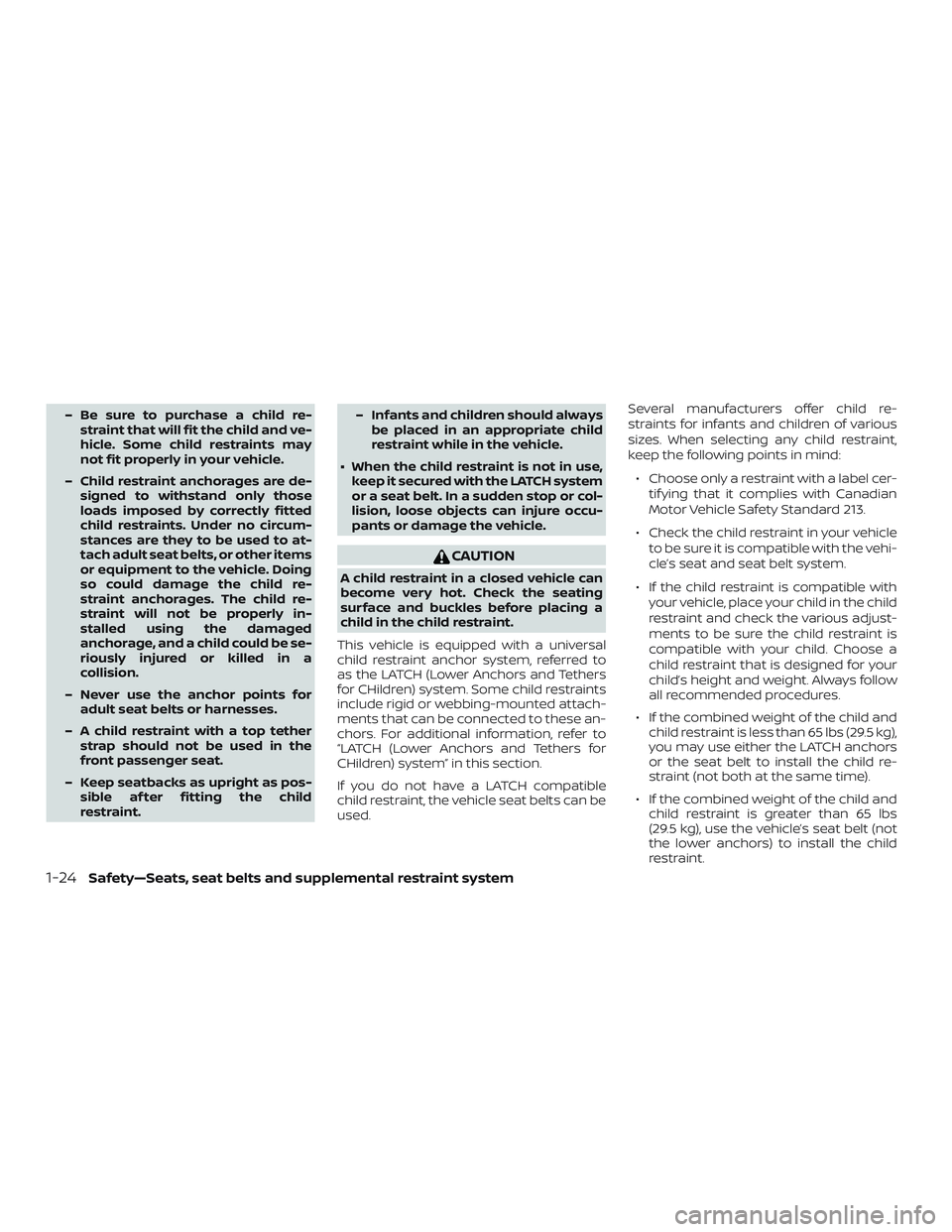
– Be sure to purchase a child re-straint that will fit the child and ve-
hicle. Some child restraints may
not fit properly in your vehicle.
– Child restraint anchorages are de- signed to withstand only those
loads imposed by correctly fitted
child restraints. Under no circum-
stances are they to be used to at-
tach adult seat belts, or other items
or equipment to the vehicle. Doing
so could damage the child re-
straint anchorages. The child re-
straint will not be properly in-
stalled using the damaged
anchorage, and a child could be se-
riously injured or killed in a
collision.
– Never use the anchor points for adult seat belts or harnesses.
– A child restraint with a top tether strap should not be used in the
front passenger seat.
– Keep seatbacks as upright as pos- sible af ter fitting the child
restraint. – Infants and children should always
be placed in an appropriate child
restraint while in the vehicle.
∙ When the child restraint is not in use, keep it secured with the LATCH system
or a seat belt. In a sudden stop or col-
lision, loose objects can injure occu-
pants or damage the vehicle.
CAUTION
A child restraint in a closed vehicle can
become very hot. Check the seating
surface and buckles before placing a
child in the child restraint.
This vehicle is equipped with a universal
child restraint anchor system, referred to
as the LATCH (Lower Anchors and Tethers
for CHildren) system. Some child restraints
include rigid or webbing-mounted attach-
ments that can be connected to these an-
chors. For additional information, refer to
“LATCH (Lower Anchors and Tethers for
CHildren) system” in this section.
If you do not have a LATCH compatible
child restraint, the vehicle seat belts can be
used. Several manufacturers offer child re-
straints for infants and children of various
sizes. When selecting any child restraint,
keep the following points in mind:
∙ Choose only a restraint with a label cer- tif ying that it complies with Canadian
Motor Vehicle Safety Standard 213.
∙ Check the child restraint in your vehicle to be sure it is compatible with the vehi-
cle’s seat and seat belt system.
∙ If the child restraint is compatible with your vehicle, place your child in the child
restraint and check the various adjust-
ments to be sure the child restraint is
compatible with your child. Choose a
child restraint that is designed for your
child’s height and weight. Always follow
all recommended procedures.
∙ If the combined weight of the child and child restraint is less than 65 lbs (29.5 kg),
you may use either the LATCH anchors
or the seat belt to install the child re-
straint (not both at the same time).
∙ If the combined weight of the child and child restraint is greater than 65 lbs
(29.5 kg), use the vehicle’s seat belt (not
the lower anchors) to install the child
restraint.
1-24Safety—Seats, seat belts and supplemental restraint system
Page 42 of 330
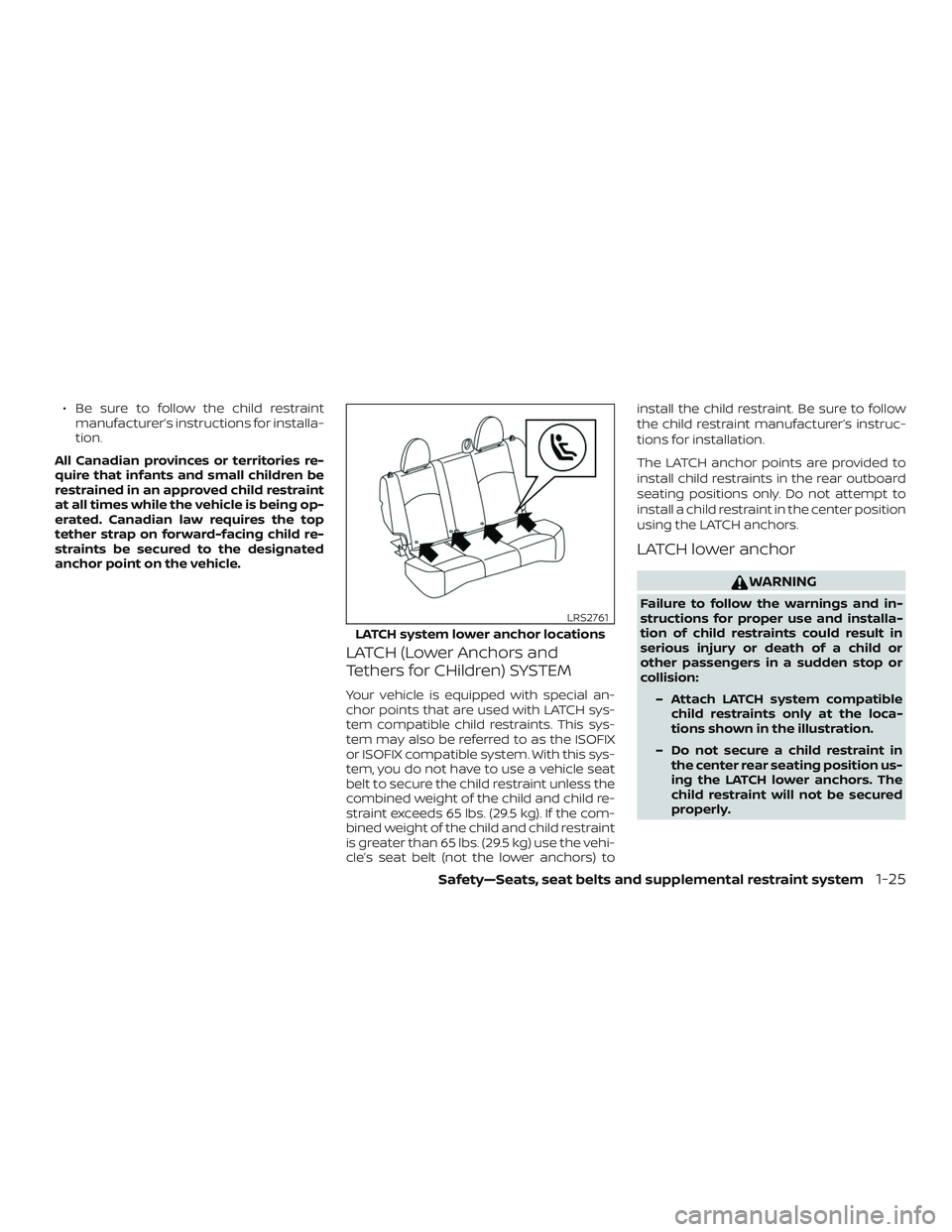
∙ Be sure to follow the child restraintmanufacturer’s instructions for installa-
tion.
All Canadian provinces or territories re-
quire that infants and small children be
restrained in an approved child restraint
at all times while the vehicle is being op-
erated. Canadian law requires the top
tether strap on forward-facing child re-
straints be secured to the designated
anchor point on the vehicle.
LATCH (Lower Anchors and
Tethers for CHildren) SYSTEM
Your vehicle is equipped with special an-
chor points that are used with LATCH sys-
tem compatible child restraints. This sys-
tem may also be referred to as the ISOFIX
or ISOFIX compatible system. With this sys-
tem, you do not have to use a vehicle seat
belt to secure the child restraint unless the
combined weight of the child and child re-
straint exceeds 65 lbs. (29.5 kg). If the com-
bined weight of the child and child restraint
is greater than 65 lbs. (29.5 kg) use the vehi-
cle’s seat belt (not the lower anchors) to install the child restraint. Be sure to follow
the child restraint manufacturer’s instruc-
tions for installation.
The LATCH anchor points are provided to
install child restraints in the rear outboard
seating positions only. Do not attempt to
install a child restraint in the center position
using the LATCH anchors.
LATCH lower anchor
WARNING
Failure to follow the warnings and in-
structions for proper use and installa-
tion of child restraints could result in
serious injury or death of a child or
other passengers in a sudden stop or
collision:
– Attach LATCH system compatiblechild restraints only at the loca-
tions shown in the illustration.
– Do not secure a child restraint in the center rear seating position us-
ing the LATCH lower anchors. The
child restraint will not be secured
properly.
LATCH system lower anchor locations
LRS2761
Safety—Seats, seat belts and supplemental restraint system1-25
Page 43 of 330
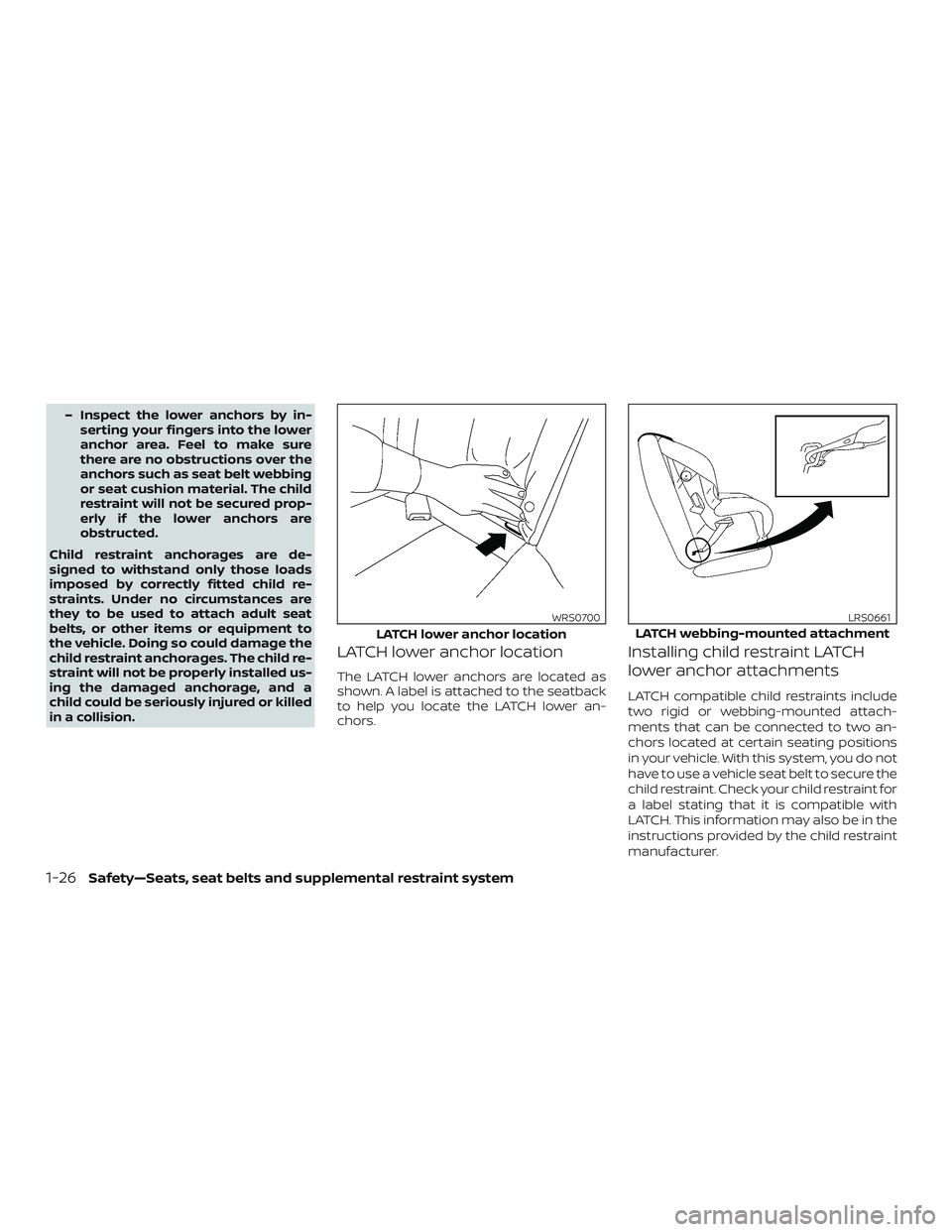
– Inspect the lower anchors by in-serting your fingers into the lower
anchor area. Feel to make sure
there are no obstructions over the
anchors such as seat belt webbing
or seat cushion material. The child
restraint will not be secured prop-
erly if the lower anchors are
obstructed.
Child restraint anchorages are de-
signed to withstand only those loads
imposed by correctly fitted child re-
straints. Under no circumstances are
they to be used to attach adult seat
belts, or other items or equipment to
the vehicle. Doing so could damage the
child restraint anchorages. The child re-
straint will not be properly installed us-
ing the damaged anchorage, and a
child could be seriously injured or killed
in a collision.
LATCH lower anchor location
The LATCH lower anchors are located as
shown. A label is attached to the seatback
to help you locate the LATCH lower an-
chors.
Installing child restraint LATCH
lower anchor attachments
LATCH compatible child restraints include
two rigid or webbing-mounted attach-
ments that can be connected to two an-
chors located at certain seating positions
in your vehicle. With this system, you do not
have to use a vehicle seat belt to secure the
child restraint. Check your child restraint for
a label stating that it is compatible with
LATCH. This information may also be in the
instructions provided by the child restraint
manufacturer.
LATCH lower anchor location
WRS0700
LATCH webbing-mounted attachment
LRS0661
1-26Safety—Seats, seat belts and supplemental restraint system
Page 44 of 330
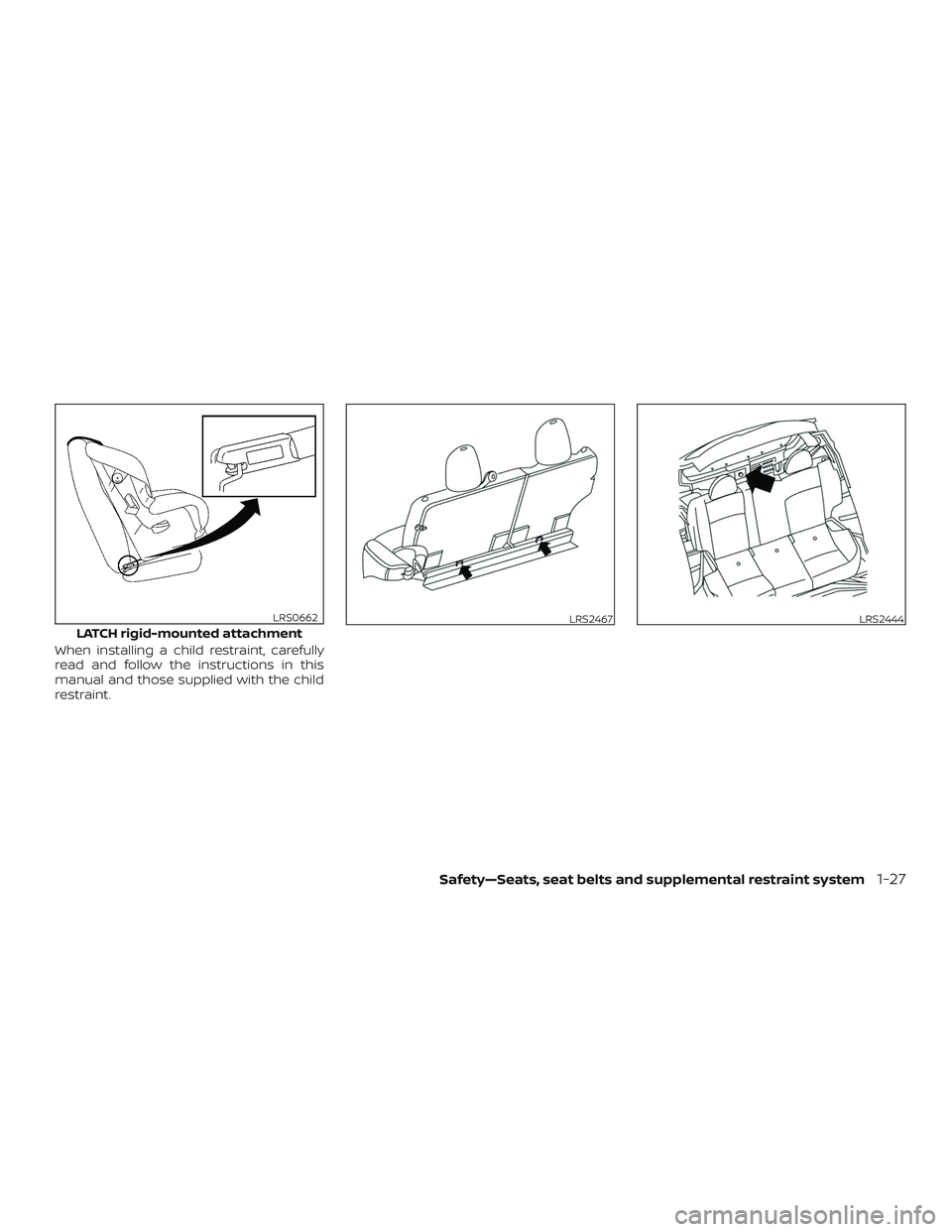
When installing a child restraint, carefully
read and follow the instructions in this
manual and those supplied with the child
restraint.
LATCH rigid-mounted attachment
LRS0662LRS2467LRS2444
Safety—Seats, seat belts and supplemental restraint system1-27
Page 45 of 330

Top tether anchor point locations
WARNING
Child restraint anchorages are de-
signed to withstand only those loads
imposed by correctly fitted child re-
straints. Under no circumstances are
they to be used to attach adult seat
belts, or other items or equipment to
the vehicle. Doing so could damage the
child restraint anchorages. The child re-
straint will not be properly installed us-
ing the damaged anchorage, and a
child could be seriously injured or killed
in a collision.
The child restraint top tether strap must be
used when installing the child restraint with
the LATCH lower anchor attachments or
seat belts. For additional information, refer
to “Installing top tether strap” in this sec-
tion.
If you have any questions when install-
ing a top tether strap child restraint, it is
recommended that you visit a NISSAN
dealer for this service.
REAR-FACING CHILD RESTRAINT
INSTALLATION USING LATCH
For additional information, refer to all Warn-
ings and Cautions in the “Child safety” and
“Child restraints” sections of this manual
before installing a child restraint.
Do not use the lower anchors if the com-
bined weight of the child and the child re-
straint exceeds 65 lbs (29.5 kg). If the com-
bined weight of the child and the child
restraint is greater than 65 lbs (29.5 kg), use
the vehicle’s seat belt (not the lower an-
chors) to install the child restraint. Be sure
to follow the child restraint manufacturer’s
instructions for installation.
Follow these steps to install a rear-facing
child restraint using the LATCH system: 1. Position the child restraint on the seat. Always follow the child restraint manu-
facturer’s instructions. 2. Secure the child restraint anchor at-
tachments to the LATCH lower an-
chors. Check to make sure the LATCH
attachment is properly attached to the
lower anchors.
Rear-facing webbing-mounted – step 2
WRS0801
1-28Safety—Seats, seat belts and supplemental restraint system
Page 46 of 330
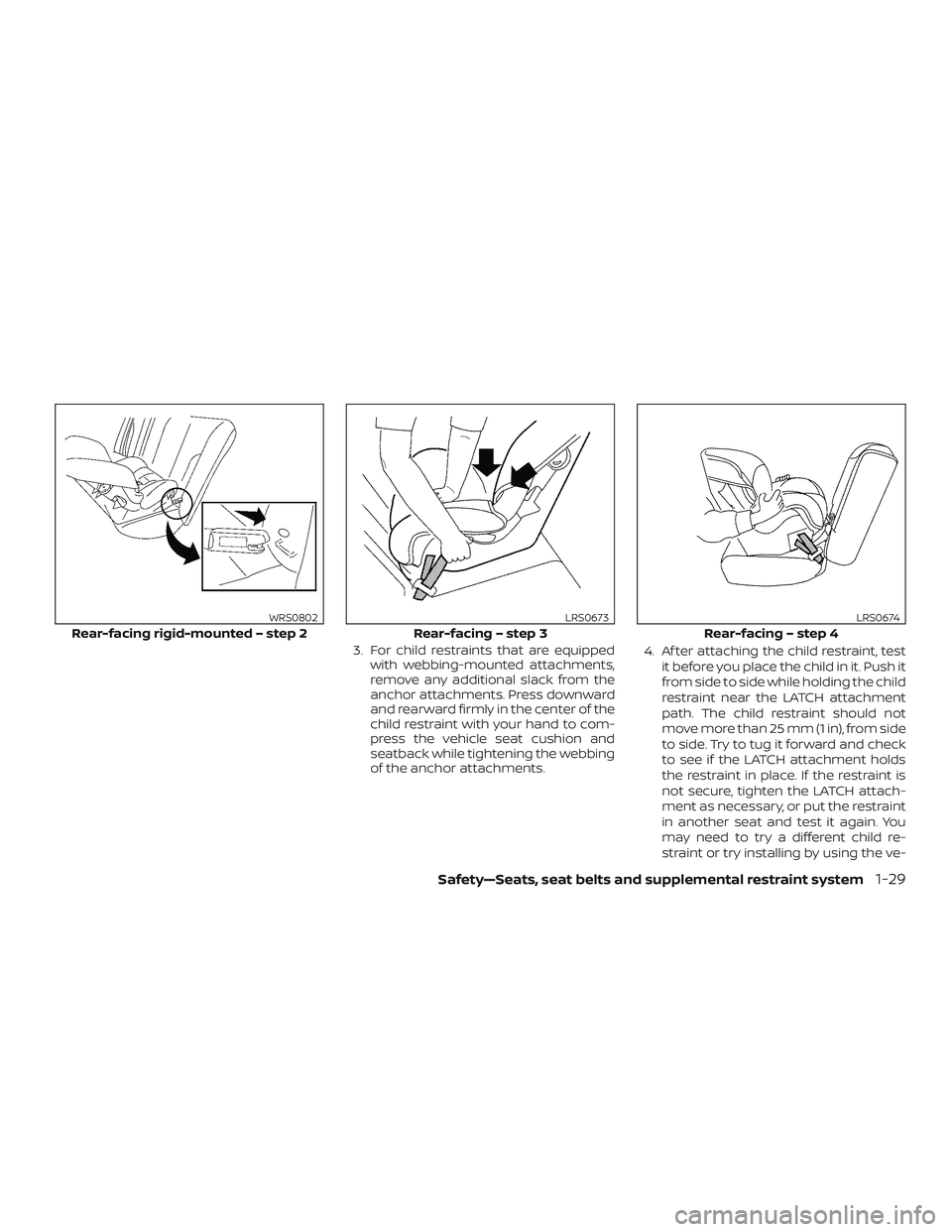
3. For child restraints that are equippedwith webbing-mounted attachments,
remove any additional slack from the
anchor attachments. Press downward
and rearward firmly in the center of the
child restraint with your hand to com-
press the vehicle seat cushion and
seatback while tightening the webbing
of the anchor attachments. 4. Af ter attaching the child restraint, test
it before you place the child in it. Push it
from side to side while holding the child
restraint near the LATCH attachment
path. The child restraint should not
move more than 25 mm (1 in), from side
to side. Try to tug it forward and check
to see if the LATCH attachment holds
the restraint in place. If the restraint is
not secure, tighten the LATCH attach-
ment as necessary, or put the restraint
in another seat and test it again. You
may need to try a different child re-
straint or try installing by using the ve-
Rear-facing rigid-mounted – step 2
WRS0802
Rear-facing – step 3
LRS0673
Rear-facing – step 4
LRS0674
Safety—Seats, seat belts and supplemental restraint system1-29
Page 47 of 330
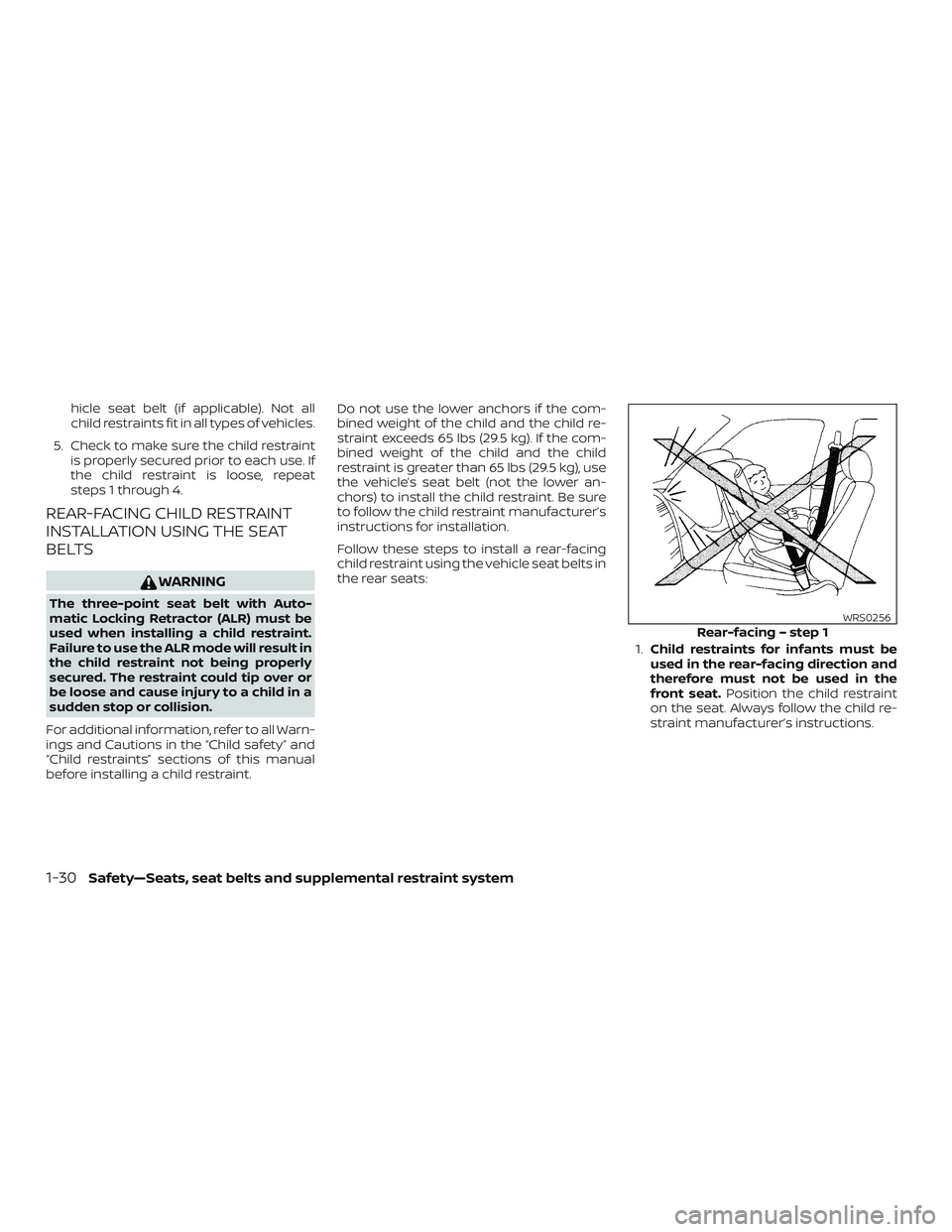
hicle seat belt (if applicable). Not all
child restraints fit in all types of vehicles.
5. Check to make sure the child restraint is properly secured prior to each use. If
the child restraint is loose, repeat
steps 1 through 4.
REAR-FACING CHILD RESTRAINT
INSTALLATION USING THE SEAT
BELTS
WARNING
The three-point seat belt with Auto-
matic Locking Retractor (ALR) must be
used when installing a child restraint.
Failure to use the ALR mode will result in
the child restraint not being properly
secured. The restraint could tip over or
be loose and cause injury to a child in a
sudden stop or collision.
For additional information, refer to all Warn-
ings and Cautions in the “Child safety” and
“Child restraints” sections of this manual
before installing a child restraint. Do not use the lower anchors if the com-
bined weight of the child and the child re-
straint exceeds 65 lbs (29.5 kg). If the com-
bined weight of the child and the child
restraint is greater than 65 lbs (29.5 kg), use
the vehicle’s seat belt (not the lower an-
chors) to install the child restraint. Be sure
to follow the child restraint manufacturer’s
instructions for installation.
Follow these steps to install a rear-facing
child restraint using the vehicle seat belts in
the rear seats:
1.Child restraints for infants must be
used in the rear-facing direction and
therefore must not be used in the
front seat. Position the child restraint
on the seat. Always follow the child re-
straint manufacturer’s instructions.
Rear-facing – step 1WRS0256
1-30Safety—Seats, seat belts and supplemental restraint system